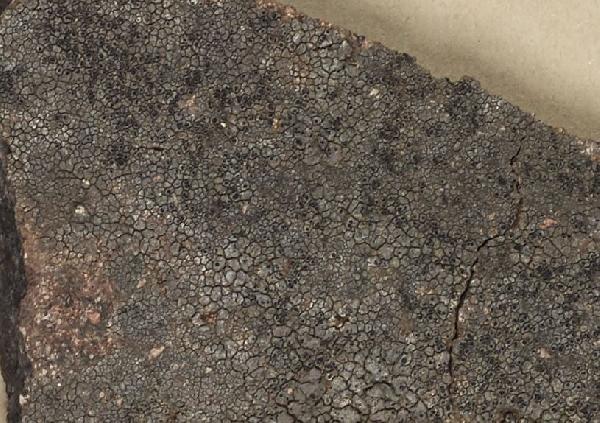Aspicilia bricconensis Hue
Nouv. Arch. Mus. Hist. Nat., Paris, 5 sér., 2: 73, 1912 (“1910”).
Synonyms: Lecanora bricconensis (Hue) Zahlbr.
Distribution: N - TAA (Roux & al. 2011, Nascimbene & al. 2022).
Description: Thallus crustose, episubstratic, 0.5-1.2 mm thick, rimose-areolate, glebulose, grey-white to dark grey, sometimes with a bluish or brownish tinge, forming large patches delimited by a dark prothalline line. Areoles 0.3-1.3 mm wide, often of different sizes in the same thallus, with a subglebulose surface. Cortex brown-pigmented in upper part (Subdepressa-brown pigment, K-, disappearing in N); medulla white to ochraceous I-. Apothecia aspicilioid, immersed, irregular in outline, sometimes confluent, 0.3-1 mm across, with a concave to flat, black, epruinose disc and a very thin, blackish, often poorly evident thalline margin. Epithecium greenish to olive, N+ emerald green; hymenium colourless, (85)-100-120(-160) µm high, 1+ blue turning reddish; paraphyses submoniliform, 1.5-1.7 μm thick at base, the apical cells up to 4 μm wide; hypothecium colourless, inspersed, 20-25 μm high, I+ pale blue. Asci 8-spored, cylindrical-clavate, the thin outer coat K/I+ blue, the wall and apical dome K/I-. Ascospores 1-celled, hyaline, ellipsoid, (12-)15-23(-25) x (6.5)9-15(-16) μm, thin-walled. Pycnidia immersed, with a black to brown, punctiform ostiole. Conidia straight, (5-)9-17 x c. 1 μm. Photobiont chlorococcoid. Spot tests: cortex usually K-; medulla K+ yellow then red (needle-like red crystals), very rarely K+ yellow or K-, C-, KC-, P+ orange-yellow. Chemistry: norstictic acid, rarely stictic acid, mainly in the medulla. Note: a poorly known, chemically variable species of siliceous rocks (see Roux & coll. 2014), reported from various localities in the southern Alps. For further details see Roux & al. (2011) and Roux & coll. (2014).
Growth form: Crustose
Substrata: rocks
Photobiont: green algae other than Trentepohlia
Reproductive strategy: mainly sexual
Poorly known taxon in need of further study
Commonnes-rarity: (info)
Alpine belt: very rare
Subalpine belt: very rare
Oromediterranean belt: absent
Montane belt: absent
Submediterranean belt: absent
Padanian area: absent
Humid submediterranean belt: absent
Humid mediterranean belt: absent
Dry mediterranean belt: absent

Predictive model
Herbarium samples

Courtesy Danièle et Olivier Gonnet - Source: https://www.afl-lichenologie.fr/Photos_AFL/Photos_AFL_A/Textes_A4/Aspicilia_bricconensis.htm
France, Alpes de Haute Provence - (04) - Jausiers - Lac des Eissaupres blocs grès d'Annot, alt. 2340 m
24/07/2015
chémo. K-

Courtesy Danièle et Olivier Gonnet - Source: https://www.afl-lichenologie.fr/Photos_AFL/Photos_AFL_A/Textes_A4/Aspicilia_bricconensis.htm
France, Alpes de Haute Provence - (04) - Jausiers - Lac des Eissaupres blocs grès d'Annot, alt. 2340 m
24/07/2015
chémo. K-
Growth form: Crustose
Substrata: rocks
Photobiont: green algae other than Trentepohlia
Reproductive strategy: mainly sexual
Poorly known taxon in need of further study
Commonnes-rarity: (info)
Alpine belt: very rare
Subalpine belt: very rare
Oromediterranean belt: absent
Montane belt: absent
Submediterranean belt: absent
Padanian area: absent
Humid submediterranean belt: absent
Humid mediterranean belt: absent
Dry mediterranean belt: absent

Predictive model
| Herbarium samples |

Courtesy Danièle et Olivier Gonnet - Source: https://www.afl-lichenologie.fr/Photos_AFL/Photos_AFL_A/Textes_A4/Aspicilia_bricconensis.htm
France, Alpes de Haute Provence - (04) - Jausiers - Lac des Eissaupres blocs grès d'Annot, alt. 2340 m
24/07/2015
chémo. K-

 INDEX FUNGORUM
INDEX FUNGORUM
 GBIF
GBIF
 DOLICHENS
DOLICHENS



